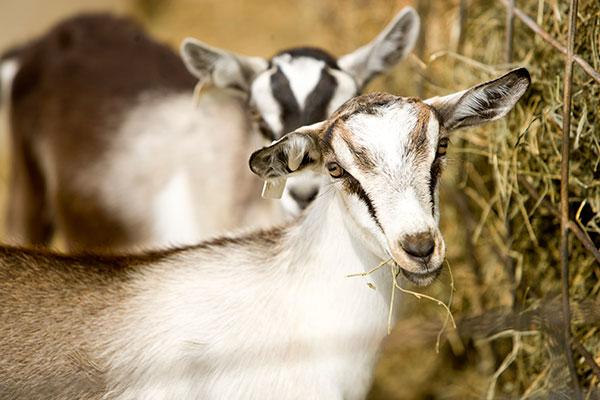
A Different Kind of Dairy
Thursday, June 1, 2017
June is National Dairy Month. In recent years, more and more people are turning to goat’s milk as their source of dairy products.
Goat milk accounts for about 2 percent of the world’s total annual milk supply. Here in Oklahoma, Langston University maintains several breeds of goats at the E (Kika) de la Garza American Institute for Goat Research including the Alpine dairy herd.
The 120-acre Main Farm is home to 90 lactating dairy goats. A creamery for dairy goat milk research and technology transfer is also housed on the Langston dairy farm.
In addition the Institute has specialized laboratories for the analysis of milk, milk products and animal fiber. The milk analysis laboratory is located on the main campus at Langston University, provides goat Dairy Herd Improvement (DHI) program services year around to all goat milk producers throughout the United States, who have enrolled in the program.
Alpine goats are bred for maximum milk production and can produce up to a gallon or more per day for about 10 months. They need to be milked 8-12 hours apart at the same times each day.
Some of the advantages of goat’s milk over cow’s milk include:
- Goats are environmentally friendly as they require less space and eat less food than cows.
- Studies link goat’s milk to an increased ability to metabolize iron and copper.
- Goat’s milk closely resembles human breast milk and is easier to digest and assimilate in the human body.
- The size of the fat molecules in goat’s milk are smaller than those in cow’s milk making it easier to digest goat’s milk.
- While cow’s milk is about 17 percent fatty acids, goat’s milk averages 35 percent fatty acids, making it more nutritionally wholesome.
Tending to the veterinary needs of the dairy goats is Dr. Lionel Dawson, professor at Oklahoma State University’s Center for Veterinary Health Sciences. Dawson specializes in theriogenology and small ruminants.
“Visits to the farm with the senior veterinary students are very interesting, as you never know what issue will need to be dealt with on that visit,” said Dawson. “It can be anything from a dairy animal not eating, not producing milk, diarrhea, lameness, or routine animal husbandry procedures, etc.”
Lionel J. Dawson, B.V.Sc., MS, DACT
Veterinary Viewpoints is provided by the faculty of the OSU Veterinary Medical Hospital. Certified by the American Animal Hospital Association, the hospital is open to the public providing routine and specialized care for all species and 24-hour emergency care, 365 days a year.
